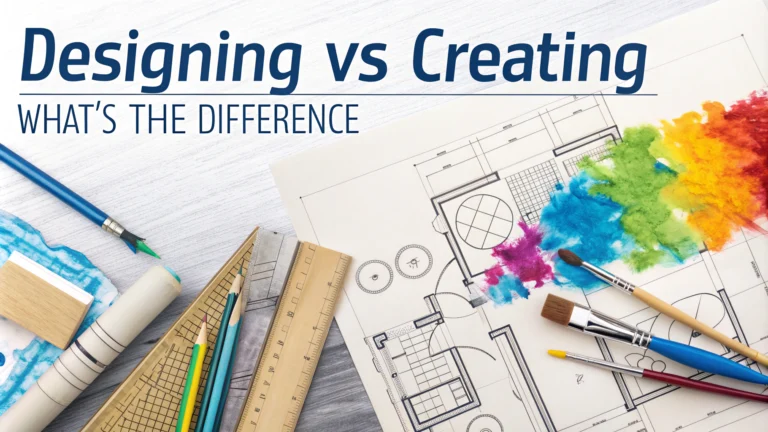Design and creation, while often used interchangeably, serve distinct purposes in the development process. **Design** focuses on planning, strategy, and conceptual work, while **creation** involves the hands-on execution and implementation of those plans.
The differences between these two processes shape how projects unfold and determine their success. Understanding when to focus on design versus creation helps professionals work more efficiently and produce better results.
Key Differences Between Designing and Creating
- Design = Planning and strategy
- Creation = Implementation and execution
- Design involves abstract thinking
- Creation requires practical skills
The Design Process Explained
- **Research and Analysis**: Understanding requirements and constraints
- **Conceptualization**: Developing ideas and solutions
- **Iteration**: Refining concepts through feedback
- **Documentation**: Creating blueprints and specifications
The Creation Phase
| Stage | Actions |
|---|---|
| Development | Building and assembling |
| Testing | Quality assurance and refinement |
| Implementation | Putting the creation into use |
“Design is not just what it looks like and feels like. Design is how it works.” – Steve Jobs
Tools and Technologies
Modern design and creation rely on specific tools that streamline workflows and enhance productivity. Selecting the right tools impacts project timelines and quality outcomes.
| Design Tools | Creation Tools |
|---|---|
| Figma, Sketch | Code editors, IDEs |
| Wireframing software | Build systems |
| Prototyping tools | Version control |
Managing Design and Creation Teams
Successful projects require clear communication between design and development teams. **Project managers** bridge the gap between these disciplines by establishing workflows and timelines.
- Set clear project milestones
- Define team responsibilities
- Maintain documentation standards
- Schedule regular check-ins
Common Challenges and Solutions
Understanding typical obstacles helps teams prepare and respond effectively. **Proactive planning** reduces the impact of common issues.
- **Scope creep**: Set clear boundaries and change management processes
- **Communication gaps**: Implement collaborative tools and regular meetings
- **Technical constraints**: Assess limitations early in the design phase
- **Resource allocation**: Plan bandwidth and expertise requirements upfront
Measuring Success
Evaluate project outcomes through specific metrics and feedback loops. Track both quantitative and qualitative measures to assess effectiveness.
| Metric Type | Examples |
|---|---|
| Performance | Speed, efficiency, reliability |
| User feedback | Satisfaction scores, usability tests |
| Business impact | ROI, market response |
“Good design is good business.” – Thomas Watson Jr.
FAQs About Designing vs Creating
What is the main difference between designing and creating?
Designing is the planning and conceptual stage where ideas are developed and structured, while creating is the actual implementation or production of those ideas into tangible results.
Can you design without creating?
Yes, many designers work solely on conceptual stages without handling the production phase. Examples include architectural designers who create blueprints but don’t build structures.
What tools are needed for design vs creation?
Design tools typically include:
- Sketching software
- Planning applications
- Mockup tools
Creation tools vary by field but often include:
- Production equipment
- Manufacturing tools
- Development software
Which pays more: design jobs or creation jobs?
Salary varies by industry, but design roles often command higher salaries due to the strategic thinking required. UX designers and architectural designers typically earn more than production staff.
How long does the design process take compared to creation?
Design typically takes 20-30% of a project’s timeline, while creation/production consumes 70-80%. However, this ratio varies significantly by industry and project scope.
What skills are needed for digital design vs digital creation?
Digital design skills:
- User experience knowledge
- Visual design principles
- Wireframing
Digital creation skills:
- Coding
- Animation
- Video production
Is graphic design considered designing or creating?
Graphic design involves both processes – designing during conceptual stages and creating during production of final assets.
What software is best for product design vs product creation?
Design software:
- Sketch
- Figma
- Adobe XD
Creation software:
- AutoCAD
- SolidWorks
- 3D printing software
Do web designers need creation skills?
Modern web designers benefit from understanding basic creation skills like HTML and CSS, but many specialize in design only and collaborate with web developers for creation.
What’s the difference between design thinking and creative thinking?
Design thinking is a structured approach to solving problems through planning and strategy. Creative thinking focuses on generating unique ideas and solutions through imagination and innovation.



















